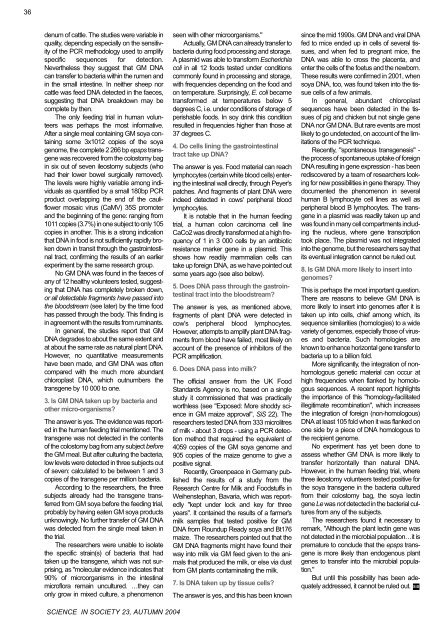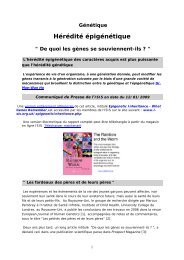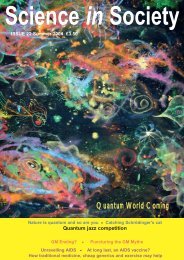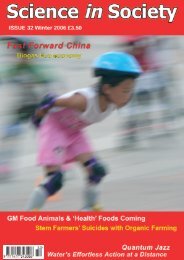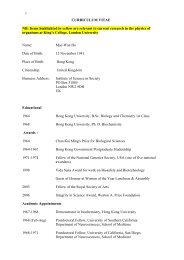Ethiopia goes organic to feed herself - The Institute of Science In ...
Ethiopia goes organic to feed herself - The Institute of Science In ...
Ethiopia goes organic to feed herself - The Institute of Science In ...
Create successful ePaper yourself
Turn your PDF publications into a flip-book with our unique Google optimized e-Paper software.
36<br />
denum <strong>of</strong> cattle. <strong>The</strong> studies were variable in<br />
quality, depending especially on the sensitivity<br />
<strong>of</strong> the PCR methodology used <strong>to</strong> amplify<br />
specific sequences for detection.<br />
Nevertheless they suggest that GM DNA<br />
can transfer <strong>to</strong> bacteria within the rumen and<br />
in the small intestine. <strong>In</strong> neither sheep nor<br />
cattle was <strong>feed</strong> DNA detected in the faeces,<br />
suggesting that DNA breakdown may be<br />
complete by then.<br />
<strong>The</strong> only <strong>feed</strong>ing trial in human volunteers<br />
was perhaps the most informative.<br />
After a single meal containing GM soya containing<br />
some 3x1012 copies <strong>of</strong> the soya<br />
genome, the complete 2 266 bp epsps transgene<br />
was recovered from the colos<strong>to</strong>my bag<br />
in six out <strong>of</strong> seven ileos<strong>to</strong>my subjects (who<br />
had their lower bowel surgically removed).<br />
<strong>The</strong> levels were highly variable among individuals<br />
as quantified by a small 180bp PCR<br />
product overlapping the end <strong>of</strong> the cauliflower<br />
mosaic virus (CaMV) 35S promoter<br />
and the beginning <strong>of</strong> the gene: ranging from<br />
1011 copies (3.7%) in one subject <strong>to</strong> only 105<br />
copies in another. This is a strong indication<br />
that DNA in food is not sufficiently rapidly broken<br />
down in transit through the gastrointestinal<br />
tract, confirming the results <strong>of</strong> an earlier<br />
experiment by the same research group.<br />
No GM DNA was found in the faeces <strong>of</strong><br />
any <strong>of</strong> 12 healthy volunteers tested, suggesting<br />
that DNA has completely broken down,<br />
or all detectable fragments have passed in<strong>to</strong><br />
the bloodstream (see later) by the time food<br />
has passed through the body. This finding is<br />
in agreement with the results from ruminants.<br />
<strong>In</strong> general, the studies report that GM<br />
DNA degrades <strong>to</strong> about the same extent and<br />
at about the same rate as natural plant DNA.<br />
However, no quantitative measurements<br />
have been made, and GM DNA was <strong>of</strong>ten<br />
compared with the much more abundant<br />
chloroplast DNA, which outnumbers the<br />
transgene by 10 000 <strong>to</strong> one.<br />
3. Is GM DNA taken up by bacteria and<br />
other micro-organisms?<br />
<strong>The</strong> answer is yes. <strong>The</strong> evidence was reported<br />
in the human <strong>feed</strong>ing trial mentioned. <strong>The</strong><br />
transgene was not detected in the contents<br />
<strong>of</strong> the colos<strong>to</strong>my bag from any subject before<br />
the GM meal. But after culturing the bacteria,<br />
low levels were detected in three subjects out<br />
<strong>of</strong> seven: calculated <strong>to</strong> be between 1 and 3<br />
copies <strong>of</strong> the transgene per million bacteria.<br />
According <strong>to</strong> the researchers, the three<br />
subjects already had the transgene transferred<br />
from GM soya before the <strong>feed</strong>ing trial,<br />
probably by having eaten GM soya products<br />
unknowingly. No further transfer <strong>of</strong> GM DNA<br />
was detected from the single meal taken in<br />
the trial.<br />
<strong>The</strong> researchers were unable <strong>to</strong> isolate<br />
the specific strain(s) <strong>of</strong> bacteria that had<br />
taken up the transgene, which was not surprising,<br />
as "molecular evidence indicates that<br />
90% <strong>of</strong> microorganisms in the intestinal<br />
micr<strong>of</strong>lora remain uncultured. …they can<br />
only grow in mixed culture, a phenomenon<br />
seen with other microorganisms."<br />
Actually, GM DNA can already transfer <strong>to</strong><br />
bacteria during food processing and s<strong>to</strong>rage.<br />
A plasmid was able <strong>to</strong> transform Escherichia<br />
coli in all 12 foods tested under conditions<br />
commonly found in processing and s<strong>to</strong>rage,<br />
with frequencies depending on the food and<br />
on temperature. Surprisingly, E. coli became<br />
transformed at temperatures below 5<br />
degrees C, i.e. under conditions <strong>of</strong> s<strong>to</strong>rage <strong>of</strong><br />
perishable foods. <strong>In</strong> soy drink this condition<br />
resulted in frequencies higher than those at<br />
37 degrees C.<br />
4. Do cells lining the gastrointestinal<br />
tract take up DNA?<br />
<strong>The</strong> answer is yes. Food material can reach<br />
lymphocytes (certain white blood cells) entering<br />
the intestinal wall directly, through Peyer's<br />
patches. And fragments <strong>of</strong> plant DNA were<br />
indeed detected in cows' peripheral blood<br />
lymphocytes.<br />
It is notable that in the human <strong>feed</strong>ing<br />
trial, a human colon carcinoma cell line<br />
CaCo2 was directly transformed at a high frequency<br />
<strong>of</strong> 1 in 3 000 cells by an antibiotic<br />
resistance marker gene in a plasmid. This<br />
shows how readily mammalian cells can<br />
take up foreign DNA, as we have pointed out<br />
some years ago (see also below).<br />
5. Does DNA pass through the gastrointestinal<br />
tract in<strong>to</strong> the bloodstream?<br />
<strong>The</strong> answer is yes, as mentioned above,<br />
fragments <strong>of</strong> plant DNA were detected in<br />
cow's peripheral blood lymphocytes.<br />
However, attempts <strong>to</strong> amplify plant DNA fragments<br />
from blood have failed, most likely on<br />
account <strong>of</strong> the presence <strong>of</strong> inhibi<strong>to</strong>rs <strong>of</strong> the<br />
PCR amplification.<br />
6. Does DNA pass in<strong>to</strong> milk?<br />
<strong>The</strong> <strong>of</strong>ficial answer from the UK Food<br />
Standards Agency is no, based on a single<br />
study it commissioned that was practically<br />
worthless (see "Exposed: More shoddy science<br />
in GM maize approval", SiS 22). <strong>The</strong><br />
researchers tested DNA from 333 microlitres<br />
<strong>of</strong> milk - about 3 drops - using a PCR detection<br />
method that required the equivalent <strong>of</strong><br />
4059 copies <strong>of</strong> the GM soya genome and<br />
905 copies <strong>of</strong> the maize genome <strong>to</strong> give a<br />
positive signal.<br />
Recently, Greenpeace in Germany published<br />
the results <strong>of</strong> a study from the<br />
Research Centre for Milk and Foodstuffs in<br />
Weihenstephan, Bavaria, which was reportedly<br />
"kept under lock and key for three<br />
years". It contained the results <strong>of</strong> a farmer's<br />
milk samples that tested positive for GM<br />
DNA from Roundup Ready soya and Bt176<br />
maize. <strong>The</strong> researchers pointed out that the<br />
GM DNA fragments might have found their<br />
way in<strong>to</strong> milk via GM <strong>feed</strong> given <strong>to</strong> the animals<br />
that produced the milk, or else via dust<br />
from GM plants contaminating the milk.<br />
7. Is DNA taken up by tissue cells?<br />
<strong>The</strong> answer is yes, and this has been known<br />
since the mid 1990s. GM DNA and viral DNA<br />
fed <strong>to</strong> mice ended up in cells <strong>of</strong> several tissues,<br />
and when fed <strong>to</strong> pregnant mice, the<br />
DNA was able <strong>to</strong> cross the placenta, and<br />
enter the cells <strong>of</strong> the foetus and the newborn.<br />
<strong>The</strong>se results were confirmed in 2001, when<br />
soya DNA, <strong>to</strong>o, was found taken in<strong>to</strong> the tissue<br />
cells <strong>of</strong> a few animals.<br />
<strong>In</strong> general, abundant chloroplast<br />
sequences have been detected in the tissues<br />
<strong>of</strong> pig and chicken but not single gene<br />
DNA nor GM DNA. But rare events are most<br />
likely <strong>to</strong> go undetected, on account <strong>of</strong> the limitations<br />
<strong>of</strong> the PCR technique.<br />
Recently, "spontaneous transgenesis" -<br />
the process <strong>of</strong> spontaneous uptake <strong>of</strong> foreign<br />
DNA resulting in gene expression - has been<br />
rediscovered by a team <strong>of</strong> researchers looking<br />
for new possibilities in gene therapy. <strong>The</strong>y<br />
documented the phenomenon in several<br />
human B lymphocyte cell lines as well as<br />
peripheral blood B lymphocytes. <strong>The</strong> transgene<br />
in a plasmid was readily taken up and<br />
was found in many cell compartments including<br />
the nucleus, where gene transcription<br />
<strong>to</strong>ok place. <strong>The</strong> plasmid was not integrated<br />
in<strong>to</strong> the genome, but the researchers say that<br />
its eventual integration cannot be ruled out.<br />
8. Is GM DNA more likely <strong>to</strong> insert in<strong>to</strong><br />
genomes?<br />
This is perhaps the most important question.<br />
<strong>The</strong>re are reasons <strong>to</strong> believe GM DNA is<br />
more likely <strong>to</strong> insert in<strong>to</strong> genomes after it is<br />
taken up in<strong>to</strong> cells, chief among which, its<br />
sequence similarities (homologies) <strong>to</strong> a wide<br />
variety <strong>of</strong> genomes, especially those <strong>of</strong> viruses<br />
and bacteria. Such homologies are<br />
known <strong>to</strong> enhance horizontal gene transfer <strong>to</strong><br />
bacteria up <strong>to</strong> a billion fold.<br />
More significantly, the integration <strong>of</strong> nonhomologous<br />
genetic material can occur at<br />
high frequencies when flanked by homologous<br />
sequences. A recent report highlights<br />
the importance <strong>of</strong> this "homology-facilitated<br />
illegitimate recombination", which increases<br />
the integration <strong>of</strong> foreign (non-homologous)<br />
DNA at least 105 fold when it was flanked on<br />
one side by a piece <strong>of</strong> DNA homologous <strong>to</strong><br />
the recipient genome.<br />
No experiment has yet been done <strong>to</strong><br />
assess whether GM DNA is more likely <strong>to</strong><br />
transfer horizontally than natural DNA.<br />
However, in the human <strong>feed</strong>ing trial, where<br />
three ileos<strong>to</strong>my volunteers tested positive for<br />
the soya transgene in the bacteria cultured<br />
from their colos<strong>to</strong>my bag, the soya lectin<br />
gene Le was not detected in the bacterial cultures<br />
from any <strong>of</strong> the subjects.<br />
<strong>The</strong> researchers found it necessary <strong>to</strong><br />
remark, "Although the plant lectin gene was<br />
not detected in the microbial population…it is<br />
premature <strong>to</strong> conclude that the epsps transgene<br />
is more likely than endogenous plant<br />
genes <strong>to</strong> transfer in<strong>to</strong> the microbial population."<br />
But until this possibility has been adequately<br />
addressed, it cannot be ruled out. SiS<br />
SCIENCE IN SOCIETY 23, AUTUMN 2004


